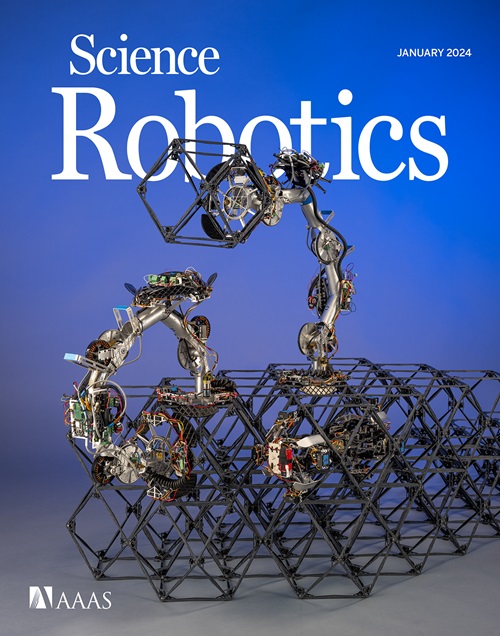Stretchable Arduinos embedded in soft robots
IF 26.1
1区 计算机科学
Q1 ROBOTICS
引用次数: 0
Abstract
To achieve real-world functionality, robots must have the ability to carry out decision-making computations. However, soft robots stretch and therefore need a solution other than rigid computers. Examples of embedding computing capacity into soft robots currently include appending rigid printed circuit boards to the robot, integrating soft logic gates, and exploiting material responses for material-embedded computation. Although promising, these approaches introduce limitations such as rigidity, tethers, or low logic gate density. The field of stretchable electronics has sought to solve these challenges, but a complete pipeline for direct integration of single-board computers, microcontrollers, and other complex circuitry into soft robots has remained elusive. We present a generalized method to translate any complex two-layer circuit into a soft, stretchable form. This enabled the creation of stretchable single-board microcontrollers (including Arduinos) and other commercial circuits (including SparkFun circuits), without design simplifications. As demonstrations of the method’s utility, we embedded highly stretchable (>300% strain) Arduino Pro Minis into the bodies of multiple soft robots. This makes use of otherwise inert structural material, fulfilling the promise of the stretchable electronic field to integrate state-of-the-art computational power into robust, stretchable systems during active use.
嵌入软体机器人的可伸缩 Arduinos
为了实现真实世界的功能,机器人必须具备进行决策计算的能力。然而,软体机器人具有伸缩性,因此需要刚性计算机以外的解决方案。目前,将计算能力嵌入软体机器人的例子包括在机器人上附加刚性印刷电路板、集成软逻辑门,以及利用材料反应进行材料嵌入式计算。这些方法虽然前景广阔,但也存在一些限制,如刚性、系绳或逻辑门密度低。可拉伸电子学领域一直在努力解决这些难题,但将单板计算机、微控制器和其他复杂电路直接集成到软体机器人中的完整流水线却一直未能实现。我们提出了一种通用方法,可将任何复杂的双层电路转化为柔软、可拉伸的形式。这样就能在不简化设计的情况下,制作出可拉伸的单板微控制器(包括 Arduinos)和其他商用电路(包括 SparkFun 电路)。为了证明这种方法的实用性,我们将高度可拉伸(300% 应变)的 Arduino Pro Minis 嵌入到多个软体机器人的身体中。这就利用了原本惰性的结构材料,实现了可拉伸电子领域的承诺,即在主动使用过程中将最先进的计算能力集成到坚固耐用的可拉伸系统中。
本文章由计算机程序翻译,如有差异,请以英文原文为准。
求助全文
约1分钟内获得全文
求助全文
来源期刊

Science Robotics
Mathematics-Control and Optimization
CiteScore
30.60
自引率
2.80%
发文量
83
期刊介绍:
Science Robotics publishes original, peer-reviewed, science- or engineering-based research articles that advance the field of robotics. The journal also features editor-commissioned Reviews. An international team of academic editors holds Science Robotics articles to the same high-quality standard that is the hallmark of the Science family of journals.
Sub-topics include: actuators, advanced materials, artificial Intelligence, autonomous vehicles, bio-inspired design, exoskeletons, fabrication, field robotics, human-robot interaction, humanoids, industrial robotics, kinematics, machine learning, material science, medical technology, motion planning and control, micro- and nano-robotics, multi-robot control, sensors, service robotics, social and ethical issues, soft robotics, and space, planetary and undersea exploration.
 求助内容:
求助内容: 应助结果提醒方式:
应助结果提醒方式:


